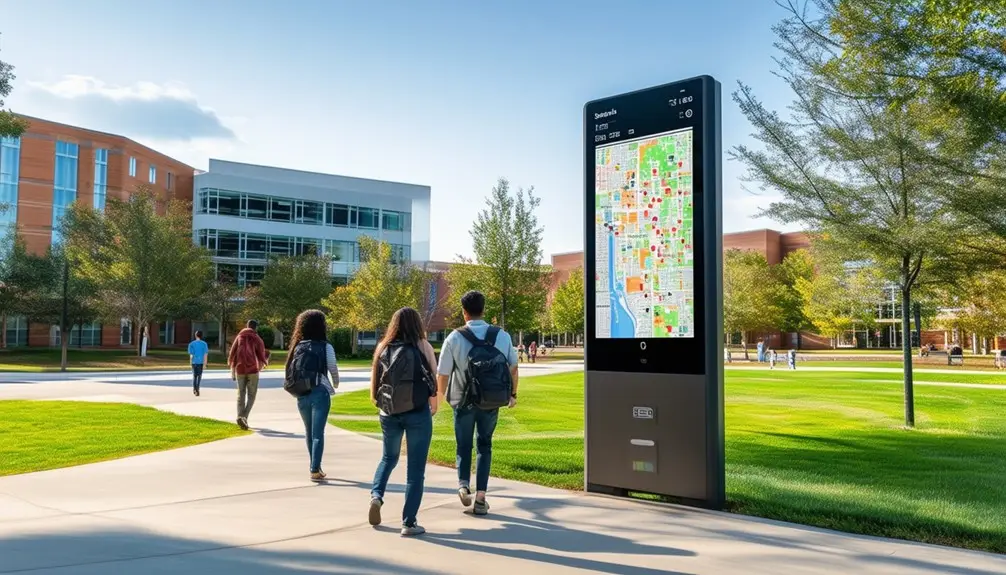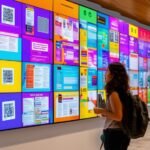You can boost campus navigation and student engagement with affordable digital wayfinding signs. These signs reduce confusion and enhance safety by providing real-time updates and emergency alerts. Look for systems offering interactive maps and customizable displays to meet your specific needs. Opt for budget-friendly options to get high value without overspending, ensuring consistent updates and innovative features. You can even consider self-financing for long-term use. With strategic placement at key decision points, these digital signs streamline navigation and create a positive visitor experience. Explore further to discover how to maximize your investment in campus wayfinding technology.
Key Takeaways
- Digital wayfinding systems provide budget-friendly options to enhance campus navigation and safety.
- Investing in digital kiosks and mobile apps ensures up-to-the-minute directions without overspending.
- Tailored digital signage solutions offer value for money with efficient, reliable, and customizable features.
- Affordable digital wayfinding signs improve the visitor experience with real-time information and interactive maps.
- Strategic placement of digital signs at key decision points reduces confusion and aids efficient navigation.
Importance of Campus Wayfinding
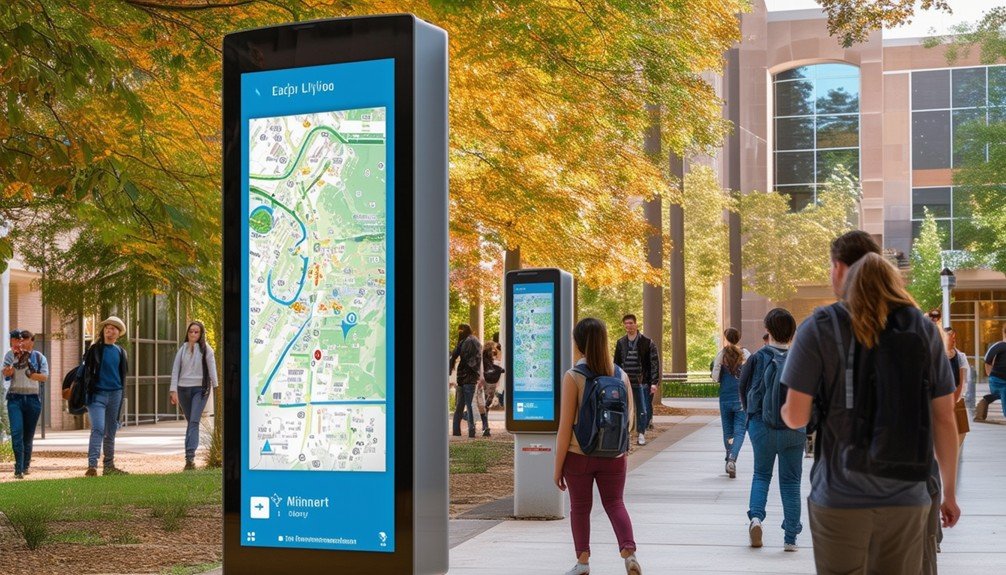
Effective campus wayfinding signage is essential for reducing confusion and ensuring everyone can easily find their way around a complex campus layout. When you implement strategic and clear wayfinding signage, you help students, faculty, visitors, and staff navigate your campus efficiently. This is particularly important during campus events, where increased foot traffic can overwhelm even the most seasoned campus-goers.
To maximize the impact of your wayfinding efforts, consider investing in digital wayfinding systems. These systems provide real-time guidance, which is invaluable for dynamic environments. Digital kiosks and mobile apps can offer up-to-the-minute directions, ensuring that everyone can reach their destinations without delay.
A budget-conscious approach doesn’t mean cutting corners; instead, focus on essential elements that provide the most significant operational benefits. Strategic placement of wayfinding signage at key decision points—entrances, intersections, and event locations—ensures that users receive clear visual cues exactly when needed.
Enhancing Student Engagement
To enhance student engagement, consider using digital wayfinding signs as a centralized communication hub. These signs can feature interactive scheduling displays and provide real-time updates, helping students stay organized and informed. Additionally, they can broadcast emergency alert notifications, ensuring campus safety and quick response times.
Centralized Communication Hub
Centralized communication hubs boost student engagement by integrating news, events, promotions, and social media feeds into a single, user-friendly application. By using digital signs across campus, you can create a dynamic centralized communication hub that keeps everyone informed and engaged. These hubs can display everything from wayfinding information to event schedules, enhancing the overall campus experience.
Digital signs are versatile. They serve as info boards, donor boards, and menu boards, welcoming guests and improving navigation. Plus, they can be a cost-effective solution for interactive scheduling in conference centers. Campus solutions are designed to elevate student engagement, improve employee satisfaction, and enhance operational efficiency. Their digital signage platforms support campus-wide communication with cloud or on-premise CMS options and CAP-compliant alert notifications.
Here’s how a centralized communication hub can benefit your campus:
| Feature | Benefit |
|---|---|
| News Integration | Keeps students updated on the latest campus news. |
| Event Scheduling | Simplifies event management and boosts participation. |
| Social Media Feeds | Engages students by displaying live social media updates. |
Implementing a centralized communication hub with digital signs is a budget-conscious way to streamline information dissemination and foster a connected campus community.
Interactive Scheduling Displays
Interactive scheduling displays enhance student engagement by providing real-time updates on events, classes, and activities, making it easier for students to stay organized and on track. These displays offer a cost-effective solution to streamline campus navigation and communication, enhancing the overall student experience. By utilizing interactive wayfinding, you can guarantee students easily find their way to different classes, meetings, or events.
Interactive displays don’t just show schedules—they provide personalized information, such as room locations and upcoming deadlines, which helps students stay on top of their commitments. This modern, dynamic communication method reduces confusion and makes the scheduling process more efficient for both students and faculty.
Here’s how interactive scheduling displays benefit your campus:
- Personalized Schedules: Students can view customized schedules tailored to their specific courses and activities.
- Real-Time Updates: Immediate notifications about changes in class locations or event times keep everyone informed.
- Easy Navigation: Interactive wayfinding helps students quickly locate rooms and facilities.
- Streamlined Communication: Important announcements and deadlines are prominently displayed, reducing missed information.
- Enhanced Efficiency: Both students and faculty save time with reduced confusion and clearer communication.
Emergency Alert Notifications
Emergency alert notifications on digital signs greatly enhance campus safety and student engagement by delivering immediate, clear, and actionable information. Implementing digital signs for emergency alerts guarantees that everyone on campus receives real-time updates, which can greatly improve response times and overall campus security.
Using digital signs for emergency alert notifications is not only a cost-effective solution but also a highly efficient way to keep students informed and engaged. By providing instant alerts, these digital signs play a vital role in promoting campus safety.
Here’s how digital signs enhance campus safety and student engagement:
| Benefit | Description | Impact on Campus Safety |
|---|---|---|
| Immediate Alerts | Real-time notifications during emergencies | Quicker response times |
| Clear Communication | Easily understandable messages | Reduced misunderstandings |
| Actionable Information | Steps to take during an emergency | Enhanced preparedness |
| Student Engagement | Keeps students informed and aware | Heightened alertness levels |
| Cost-Effective Solution | Affordable way to improve safety | Budget-friendly implementation |
Incorporating these digital signs into your campus infrastructure guarantees that you’re not only prepared for emergencies but also actively engaging students in safety protocols. This operational focus on using emergency alert notifications through digital signs makes your campus a safer place while being mindful of budget constraints.
Promoting Campus Safety
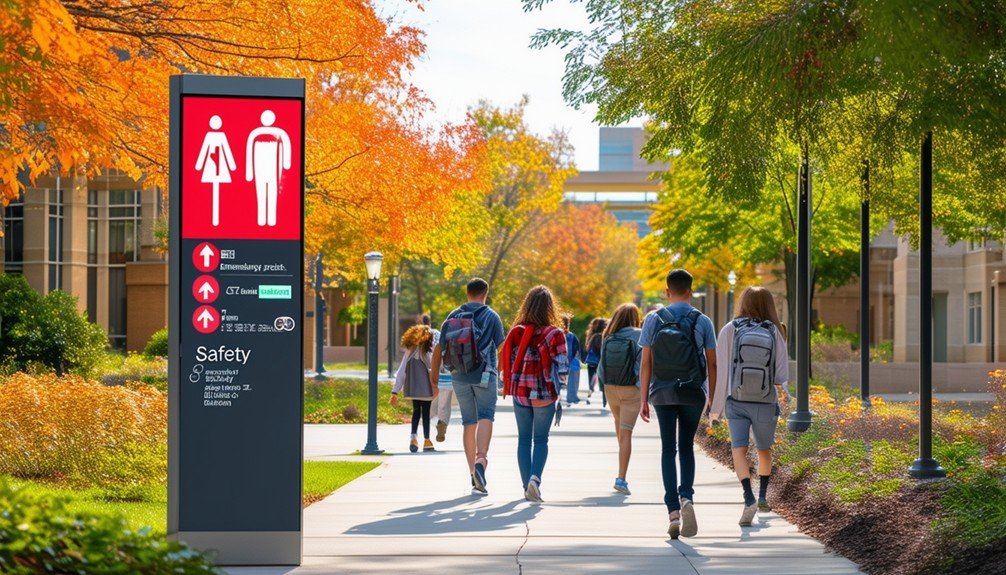
Effective campus wayfinding digital signs greatly enhance safety by providing real-time navigation and emergency alerts. With a well-implemented campus wayfinding system, you can guarantee that students, faculty, and visitors can quickly and efficiently locate key areas, which is essential during emergencies. These signs have advanced safety features that make critical information easily accessible.
Digital wayfinding signage isn’t just about directions; it’s a crucial safety tool. Emergency alerts can be instantly broadcast across multiple signs, guiding individuals to safe zones or evacuation points. This integration of safety features ensures everyone on campus receives timely updates and instructions, maximizing overall safety.
By investing in an affordable digital wayfinding system, you’re prioritizing the well-being of your campus community without overspending. Here are some key benefits:
- Real-time navigation: Helps people find their way quickly, reducing confusion in emergencies.
- Instant emergency alerts: Delivers critical information promptly.
- Safe zone guidance: Directs individuals to designated safe zones during crises.
- Accessibility: Ensures that everyone, including those with disabilities, can access important safety information.
- Cost-effective: Provides a budget-conscious solution to enhance campus security.
Implementing these systems will boost safety and streamline campus operations, making it a smart and practical investment.
Innovative Design Strategies
While prioritizing campus safety with digital directional signs, incorporating innovative design strategies guarantees these tools are also user-friendly and visually engaging. You can enhance route efficiency and improve the overall visitor experience by integrating vibrant ground markings, engaging signage, and creative directional map displays. These elements not only guide students, faculty, and visitors through sprawling campuses, but they also add a touch of aesthetic appeal that enhances the environment.
Strategic placement of digital signage at key decision points is vital. Make sure that your signs are visible and easily accessible, helping users locate various campus locations without difficulty. By focusing on these strategic points, you can maximize the effectiveness of your wayfinding system.
Using creative designs and visual cues, you can make exploring the campus a seamless experience. Consider incorporating colors, symbols, and even interactive maps to provide clear guidance. These design choices don’t have to break the bank; you can achieve an effective system within a reasonable budget by prioritizing essential areas and utilizing cost-effective materials.
Leveraging Advanced Technology
How can advanced technology in digital wayfinding signs transform campus navigation, making it more intuitive and user-friendly for everyone? By integrating advanced features, digital wayfinding solutions can greatly enhance the experience for students, faculty, and visitors. Interactive maps and real-time updates offer precise, dynamic routing information, reducing confusion and saving time.
Implementing robust wayfinding software on your campus can streamline navigation. This software provides customizable designs to meet diverse user needs, guaranteeing that every visitor finds their way easily. Mobile app integration allows users to access wayfinding information on the go, adding a layer of convenience that static signs can’t offer.
Here are the key benefits of leveraging advanced technology in your digital wayfinding solution:
- Interactive Maps: Provide real-time, detailed routing information.
- Mobile Integration: Users can access navigation assistance on their smartphones.
- Customizable Designs: Tailor the interface to meet specific campus needs.
- Real-time Updates: Guarantee information is always current and accurate.
- Analytics and Reporting: Gain insights to improve wayfinding strategies.
Customization and User Experience
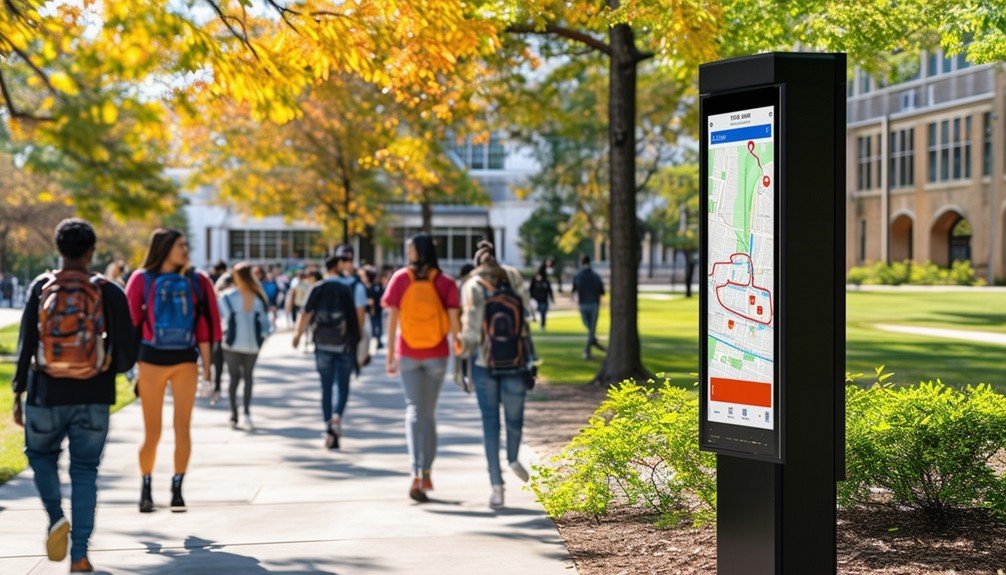
By tailoring digital wayfinding signs to meet your university’s specific needs and branding, you can greatly enhance user satisfaction and engagement. Customizability is pivotal. This means integrating your institution’s colors, logos, and specific navigation requirements into the signage. When your signs reflect your unique identity, students and visitors will find it easier to navigate and connect with the campus environment.
One key aspect is user-friendly content management. Choose software that allows for easy updates and modifications. You should be able to quickly change information to keep it current without needing extensive technical knowledge. This saves both time and resources while ensuring accurate, up-to-date information is always available.
Interactive elements add another layer of engagement. Features like touch screens, digital maps, and even selfie cameras can make the wayfinding experience more engaging and enjoyable. Customizable borders and interactive features can turn a functional tool into an exciting aspect of campus life. These elements not only help users find their way but also create memorable experiences that enhance your university’s appeal.
Affordability and Value
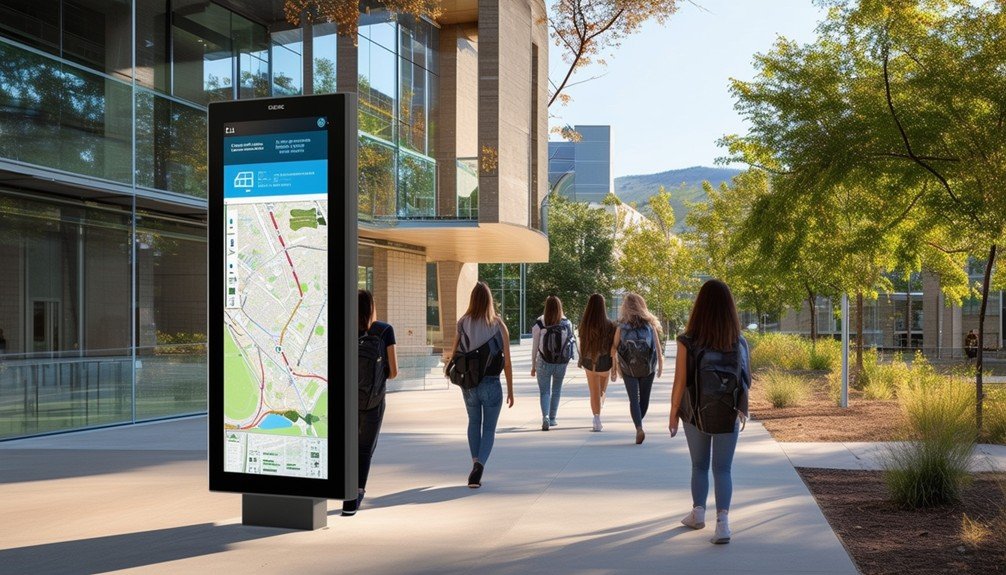
Finding cost-effective digital wayfinding signage doesn’t mean compromising on quality or functionality. In higher education, it’s important to find solutions that help students navigate the campus efficiently without breaking the bank. Here are some key points to keep in mind when evaluating affordable options:
- Budget-Friendly: Many economical digital signage options are available, making them accessible for universities with tight budgets.
- Value for Money: Ensure the signage system meets all navigation needs and provides value by being efficient and reliable.
- Consistent Updates: Look for systems that offer regular updates and innovative features, ensuring long-term usability without additional costs.
- Self-Financing: Reflect on whether the system can eventually finance itself through improved campus navigation and operational efficiency.
- Safety and Security: Affordable digital wayfinding solutions can enhance campus safety and security by providing clear, updated directions.
Visitor Experience Enhancement
Affordable digital directional signage not only saves costs but also greatly enhances the visitor experience by upgrading visitor centers to create positive first impressions and boost engagement. By investing in digital wayfinding for colleges, you’re transforming the lobby experience into a reflection of your institution’s values. This creates an immediate sense of welcome and professionalism, which notably improves visitor satisfaction.
Interactive engagement is key. Digital signs can provide real-time information, interactive maps, and personalized content that make traversing the campus effortless. This not only enhances the ease of finding destinations but also allows visitors to interact with the university’s brand in a meaningful way, thereby improving their overall perception.
Operationally, upgrading visitor centers with digital directional solutions streamlines the flow of information and reduces the need for additional staff. This leads to cost savings and greater efficiency. Additionally, these enhancements can drive revenue growth through increased sales at campus stores, higher donations from impressed alumni, and greater loyalty from all visitors.
Conclusion
By investing in affordable campus wayfinding digital signs, you’re not just enhancing student engagement and promoting safety; you’re leveraging advanced technology for a streamlined, user-friendly experience. While innovative design strategies captivate, it’s the customization that truly aligns with your campus’s unique needs. Balancing budget constraints with operational efficiency, these signs transform visitor experiences, making navigation both intuitive and enjoyable. So, choose smart solutions that seamlessly blend affordability with high value, ensuring everyone feels right at home on your campus.
Frequently Asked Questions
How Are Digital Signs Powered and Maintained?
You’ll power digital signs using electricity, often connected to existing infrastructure. Maintenance involves regular software updates and hardware inspections. Ensure you budget for ongoing costs, including potential repairs and occasional component replacements, to keep them running smoothly.
Can the Signs Be Integrated With Existing Campus Security Systems?
Yes, you can integrate the signs with existing campus security systems. Confirm compatibility by consulting both vendors. This integration can enhance security, streamline operations, and maximize your investment without notably increasing your budget.
Are These Signs Weather-Resistant for Outdoor Use?
Yes, these signs are weather-resistant for outdoor use. They feature durable materials and protective coatings to withstand harsh weather conditions. This guarantees longevity and reduces maintenance costs, making them a budget-friendly, operationally efficient solution for your campus.
How Often Do the Digital Maps and Information Need Updating?
Digital maps and information typically need updating every semester. About 70% of universities update quarterly. Regular updates guarantee accuracy and relevance, helping you manage your budget and operations efficiently while keeping campus navigation user-friendly.

